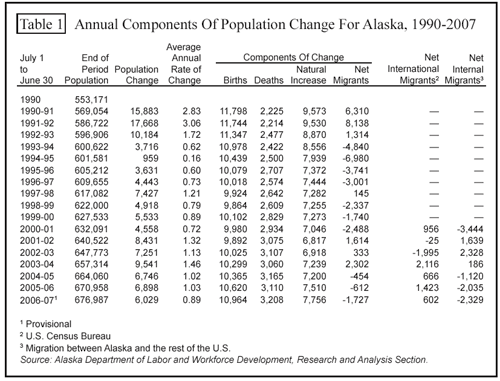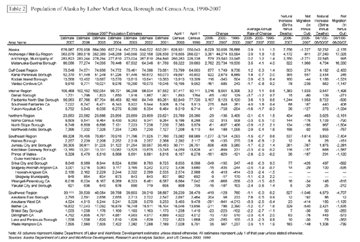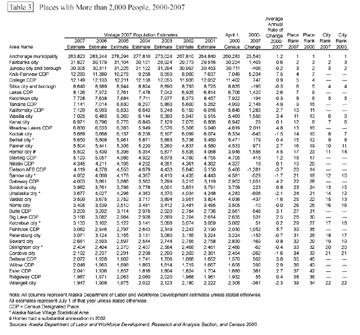 Southeast region continued to have largest overall population decline February 10, 2008
Alaska's growth was slightly faster than the 6.9 percent increase for the United States as a whole during the seven-year period. (Unless otherwise indicated, all population estimates have a reference date of July 1. The 2007 estimates are provisional.) The number of people living in Alaska climbed from 627,533 in 2000 to 676,987 in 2007 (See Table 1). Alaska's average annual rate of population change was 1.1 percent during the 2000-2007 period and 0.9 percent for the 2006-2007 period. Alaska is still the 47th most populous state, and is larger than North Dakota, Vermont, the District of Columbia and Wyoming.  Currently, growth in Alaska as a whole is primarily through natural increase. From 2000 to 2007, Alaska's natural increase (births minus deaths) added 50,486 people, while net-migration (in-migration minus out-migration) accounted for a loss of 1,032 people. During the 2006-2007 period, Alaska added 7,756 people through natural increase and lost 1,727 people to net out-migration. In the early 1990s, Alaska added an average of 8,100 people each year through natural increase. A gradual decline in births and a gradual increase in deaths - both tied to an aging population - have resulted in a slowdown in natural increase to about 7,300 people a year. When international and domestic migration are considered separately, the loss of 1,727 migrants between 2006 and 2007 breaks down to a gain of 602 international migrants and a loss of 2,329 domestic migrants. Thus, international migration is currently compensating for some of the outward domestic migration. About 70,000 people now migrate to and from Alaska each year. In- and out-migration are nearly equal at about 35,000. "It is important to note that, because our estimates are for resident population, any troops deployed overseas are counted as being in Alaska in our estimates," said Greg Williams, state demographer. "This means that the populations for the Fairbanks North Star Borough and the Municipality of Anchorage, where the main Alaska military bases are located, as well as other communities with a substantial National Guard presence, may be somewhat lower than these estimates indicate, depending on the current deployment of military and National Guard personnel." Boroughs and Census Areas Department of Labor population estimates have also been released for Alaska's 28 boroughs and census areas (see Table 2), as well as for 343 places located throughout the state. Unlike Table 1, which considers population change from the average annual population in 2000, Table 2 considers population change from the April 1, 2000 U.S. Census.
Most of Alaska's boroughs and census areas grew slowly or lost population between the 2000 Census and 2007. Of the 28 boroughs and census areas, 10 gained population between 2000 and 2007. The largest population increases occurred in the Municipality of Anchorage (+23,540), Matanuska-Susitna Borough (+20,734), Fairbanks North Star Borough (+8,123), Kenai Peninsula Borough (+2,679), Southeast Fairbanks Census Area (+848), Bethel Census Area (+786) and Wade Hampton Census Area (+567). Population growth in the Municipality of Anchorage and the Mat-Su Borough accounted for roughly 76.5 percent of the growth in those 10 boroughs and census areas. The Municipality of Anchorage made up 40.7 percent of the growth, with population gains in the Mat-Su Borough making up 35.8 percent. The Mat-Su Borough continued in 2007 to be the fastest-growing area in the state, as it has been since 1990. Between 2000 and 2007, it grew at an average annual rate of 4.1 percent, which is slightly greater than its 4.0 percent annual growth rate during the 1990s. However, its growth slowed to 3.5 percent between 2006 and 2007. The increases in both the Municipality of Anchorage and the Mat-Su Borough in the 2000-2007 period were due to a mix of natural increase and net-migration. A substantial part of migration to Anchorage comes from other parts of Alaska. The Mat-Su Borough was the only area of the state where growth came primarily from net in-migration. Since the 2000 Census, net in-migration accounted for 16,030 of the Mat-Su Borough's population increase of 20,734. The majority of Mat-Su's migration comes from the Municipality of Anchorage. Those two areas, plus the Southeast Fairbanks Census Area (+408) and Kenai Peninsula Borough (+245), were the only areas where in-migration noticeably exceeded out-migration during the 2000-2007 period. In the more recent 2006-2007 period, Anchorage gained a total of 579 people, while the Mat-Su Borough gained 2,782 people. And while Anchorage had a current natural increase of 3,350 compared to the Mat-Su Borough's 822, Mat-Su gained 1,960 migrants and Anchorage lost 2,771. Eighteen boroughs and census areas lost population between 2000 and 2007. The Southeast region continued to have the largest overall decline, losing 5.1 percent of its population since 2000, with a natural increase of 3,650 people and a net out-migration of 7,404 people. No Southeast area had long-term growth between 2000 and 2007. In the 2006-2007 period, only Haines Borough (+18) had any population gain. In all Southeast areas except Haines, out-migration was greater than natural increase. In part, that was due to population aging in the region. Between 2000 and 2007, net out-migration from Southwest Alaska (-4,707) was greater than the natural increase in the region (+4,579). The Southwest areas that increased were the Bethel Census Area, Wade Hampton Census Area and Aleutians East Borough. In every other area of Southwest, net out-migration exceeded natural increase. In the Northern region, natural
increase (+3,025) failed to keep up with out-migration (-3,161). During the 2006-2007 period, the Valdez-Cordova Census Area declined as net out-migration (-239) exceeded natural increase (+78). In the Kenai Peninsula Borough, however, both natural increase (+365) and net-migration (+557) were positive. The Kodiak Island Borough grew through natural increase (+160) despite slight out-migration (-44). In the Interior, the Fairbanks North Star Borough (+8,123) and Southeast Fairbanks Census Area (+848) grew in the 2000-2007 period, largely due to natural increase. The Yukon-Koyukuk Census Area (-758) and Denali Borough (-162) shrank as out-migration exceeded natural increase. During the 2006-2007 period, the Fairbanks North Star Borough (+3,197) and Southeast Fairbanks Census Area (+275) grew. In the former, natural increase (+1,244) was exceeded by net in-migration (+1,953). The net inmigration was mostly military and dependents. The Southeast Fairbanks Census Area gained as a result of both natural increase and net in-migration tied to missile defense. Places Alaska had 35 places with populations of more than 2,000 in the year 2000 (see Table 3); 22 of them were incorporated cities or city-boroughs in 2007. Thirty-two places in Alaska had populations of more than 2,500 in 2007, meeting the old U.S. Census Bureau defi nition of urban place.
The Municipality of Anchorage continued to dominate the state. Its population of 283,823 in 2007 accounted for 41.9 percent of the state's population, up slightly from 41.5 percent in 2000. The Anchorage/Mat-Su region (363,879) accounted for 53.7 percent of Alaska's population in 2007, up from 51.0 percent in 2000. The 15 places with populations greater than 2,000 that have had the highest average annual growth rates since the 2000 Census include the Knik-Fairview Census Designated Place, or CDP, (+7.5 percent), Fishhook CDP (+5.7 percent), Tanaina CDP (+4.9 percent), Meadow Lakes CDP (+4.8 percent), Homer city (+4.5 percent), Gateway CDP (+4.2 percent), Deltana CDP (+3.8 percent), Wasilla city (+3.4 percent), Butte CDP (+3.1 percent), Willow CDP (+2.9 percent), Kalifornsky CDP (+2.7 percent), Ester CDP (+2.7 percent), Palmer city (+2.7 percent), Lakes CDP (+2.6 percent) and Big Lake CDP (+2.5 percent). All but four of the top 15 places that experienced the most rapid growth in the 2000-2007 period are in the Mat- Su Borough. Indeed, if they were to incorporate, three places in the Mat-Su Borough would be larger than Wasilla city and an additional CDP, Meadow Lakes, would be bigger than Palmer city. Knik-Fairview would become the fourthlargest city in the state. Of the remaining four rapidly growing places, the Kalifornsky CDP and Homer city are in the Kenai Peninsula Borough, Deltana is in the Southeast Fairbanks Census Area and Ester CDP is in the Fairbanks North Star Borough. Homer's growth is largely due to its annexation of a substantial part of Diamond Ridge CDP and Miller Landing CDP in 2002. "Outside the Anchorage/Mat-Su region, a majority of communities are flat or declining," Williams said. "Fourteen of the places that had more than 2,000 people in 2000 have since declined. In fact, 195 (56.9 percent) of the 343 places in Alaska have had either zero gains or population losses since the 2000 Census. That includes four of the largest communities: the Juneau city and borough, Sitka city and borough, Ketchikan city and Kodiak city." The larger places that declined an average by more than 1.0 percent each year during the 2000-2007 period were Eielson Air Force Base CDP (-3.7 percent), Wrangell city (-2.3 percent), Unalaska city (-2.1 percent), Barrow city (-1.7 percent), Valdez city (-1.6 percent), Cordova city (-1.6 percent), Kodiak city (-1.5 percent) and Seward city (-0.8 percent). Wrangell slipped below a population of 2,000 in 2005.
Related Information: Population estimates are available on the Research and Analysis' Web site at almis.labor.state.ak.us. Click on "Population & Census" on the left and pull down to "Estimates & Projections." Then, toward the middle of the page, click on "Alaska Population Estimates 2000-2007," and then "Vintage 2007 Estimates."
Source of News:
Publish A Letter in SitNews Read Letters/Opinions
|
|||

